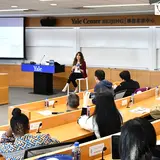Yale Program on Financial Stability Presents Financial Crisis-Fighting Playbook
This year, the program will conclude the New Bagehot Project, an unprecedented, decade-long effort to chronicle and analyze responses to financial crises throughout history and around the world, and shift its focus to dissemination of its findings.

The Yale Program on Financial Stability (YPFS), created at Yale SOM in the wake of the Global Financial Crisis (GFC) of 2007–2009, will soon conclude its flagship project: a 10-year effort to capture information about the interventions carried out during past financial crises and establish an updated playbook for fighting future crises.
The effort is called the New Bagehot Project, named for Walter Bagehot, whose 1873 book Lombard Street established the framework for responding to financial crises. The New Bagehot Project includes more than 300 case studies of individual actions by central banks and other authorities, focusing on the key design decisions of each intervention, and the results of these interventions, as well as surveys drawing wider conclusions about the lessons learned. New Bagehot Project materials are distributed through two online channels: a novel platform developed by YPFS, and YPFS’s quarterly Journal of Financial Crises. YPFS also conducted around 150 interviews with crisis decision-makers and experts to augment its document-based research with “Lessons Learned.” The nearly 19,000 primary source documents underlying this research are available through the YPFS Resource Library.
The project, says Andrew Metrick, the Janet L. Yellen Professor of Finance and Management and the director of YPFS, grew out of his experience working in the White House during the GFC, when he and other staffers were frequently “flying by the seat of our pants.”
“We had to make a lot of decisions without really understanding the history,” he says. “There had been a lot of attempts by governments to fight financial crises in the past, but we really hadn’t learned from them.”
In a future crisis, Metrick says, policymakers will be able to turn to New Bagehot to gain crucial historical context. “We have presented the knowledge so that it could be useful to somebody if they only have a few hours between when they learn of the problem and when they’re going to need to show up at a meeting with ideas. And perhaps even more important, we highlight the ideas that didn’t turn out so well. If we succeed, the next time there is a crisis, we will not make nearly as many mistakes.”




Former U.S. Treasury Secretary Timothy Geithner, who serves as the chair of the YPFS advisory board, was the president of the Federal Reserve Bank of New York when the GFC began.
“When I went to the New York Fed, my colleagues there said they had something they called the Doomsday Book, which was this big fat binder of precedent, everything the Fed had done in the last major financial crisis in the United States,” he remembers. “And I looked at that book and it didn’t actually have much in it, because the U.S. hadn’t been through a major financial crisis since the Great Depression. We needed a better body of knowledge to help us navigate the crisis.”
In the New Bagehot Project, he says, YPFS “has helped build that body of knowledge so that our successors—central banks, finance ministries—have better knowledge to draw from when they face the next crisis.”
He adds, “Most people come into these jobs without the experience of having lived through a crisis. It’s hugely valuable to look at the experiences drawn from countries around the world that faced similar crises and look at what worked and what didn’t work. Having a neutral, objective, expert-curated assessment of those precedents can help shorten the gap between problem and action and help improve the odds that what people do at the beginning is closer to the frontier of the possible and closer to the frontier of what works.”
Having assembled an unprecedented body of knowledge about financial crises, YPFS will now turn additional attention to the other half of its mission: disseminating that knowledge to central bankers and other financial regulators around the world. Since its founding, the program has held annual events gathering economists and senior policymakers for discussions of systemic risk, and since 2017 has offered a one-year Master’s Degree in Systemic Risk aimed at early- and mid-career regulators.
Metrick says he is grateful for the hard work of the people who have built this unique resource over the course of a decade: Christian McNamara, director of the New Bagehot Project; June Rhee, a senior researcher and the director of the Master’s Degree in Systemic Risk; Roz Wiggins, director of the Global Financial Crisis Project and the Lessons Learned Oral History Project; Greg Feldberg, director of research; Deborah Felstehausen, the team’s editorial director; Steven Kelly, associate director of research; Shavonda Brandon, who oversaw the YPFS Resource Library; and more than 35 research associates.
“The New Bagehot Project,” Metrick says, “is very much a team effort. And the value of that effort will only grow over time as more and more policymakers draw on the examples and analysis collected by this group. I believe this project will make future financial crises more manageable by giving us better understanding of the interventions that work best.”
Yale Program on Financial Stability, 2013–2025 Report
The Yale Program on Financial Stability was founded in 2013 for the “creation, dissemination, and preservation” of knowledge about financial crises. Read more about its achievements in its first 12 years.



